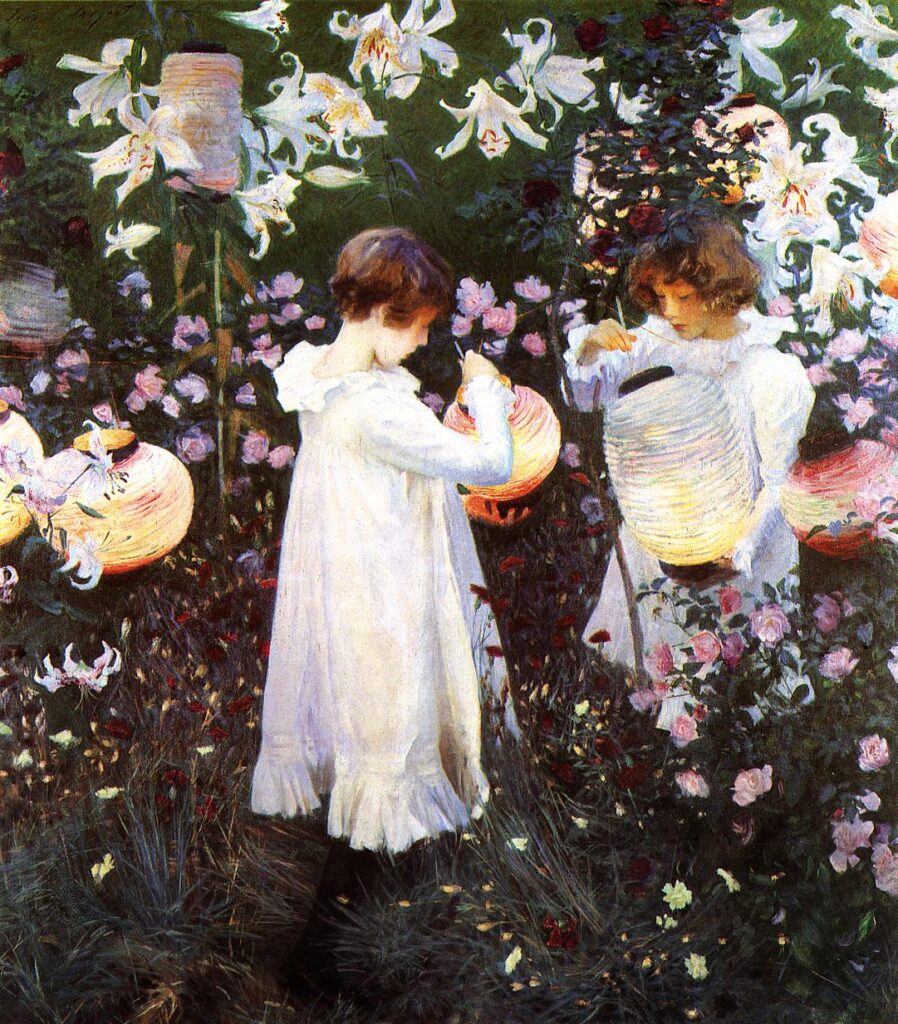Commemorating the centenary of John Singer Sargent’s death: 2 London

By 1880, just two years after he had completed his training under Carolus-Duran in Paris, John Singer Sargent was in the ascendant. His skills were in growing demand for the portraits of the rich and famous, and he also took time to travel and paint abroad, mainly in Spain and Italy.
John Singer Sargent (1856–1925), Spanish Dancer (1880-81), other details not known. Wikimedia Commons.
When he was in Spain in around 1880-81, he painted this Spanish Dancer.
John Singer Sargent (1856–1925), Venetian Glass Workers (1880-82), oil on canvas, 56.5 × 84.5 cm, Art Institute of Chicago, Chicago, IL. Wikimedia Commons.
During a visit to Italy in the period 1880-82, he painted these Venetian Glass Workers.
In early 1883, Sargent made overtures to one of the best-known young socialites in Paris, Virginie Amélie Avegno Gautreau, a French creole immigrant from New Orleans, who had married the French banker Pierre Gautreau. Her beauty was the talk of the town, and numerous artists had asked to paint her portrait as a means of promoting their own careers. The first request that she accepted was Sargent’s, in February 1883. She proved a reluctant sitter, and it wasn’t until June of the following year that Sargent was able to pin her down in her estate in Brittany to start preparatory studies. He didn’t complete the finished work until well into the autumn.
John Singer Sargent (1856–1925), Portrait of Madame X (1884), oil on canvas, 235 x 110 cm, Metropolitan Museum of Art, New York, NY. Wikimedia Commons.
We can’t see his original version of Madame X, as its reception drove him to make alterations to tone down its overt eroticism. Her pose was considered sexually suggestive, and one strap of her gown had fallen down her shoulder adding to the image’s sexuality. It caused a scandal when exhibited at the Salon, and was lampooned mercilessly in the press.
Sargent sought temporary solace flirting with the fashion for Impressionism.
John Singer Sargent (1856–1925), Claude Monet Painting by the Edge of a Wood (c 1885), oil on canvas, 54 x 64.8 cm, The Tate Gallery (Presented by Miss Emily Sargent and Mrs Ormond through the Art Fund 1925), London. © The Tate Gallery and Photographic Rights © Tate (2017), CC-BY-NC-ND 3.0 (Unported), http://www.tate.org.uk/art/artworks/sargent-claude-monet-painting-by-the-edge-of-a-wood-n04103
He had first met Claude Monet in 1876, but it’s thought that this painting of Claude Monet Painting by the Edge of a Wood was made in 1885, when they were painting together at Monet’s house in Giverny. At the right is Alice, Monet’s wife.
That year Sargent decided to move his portraiture studio away from the scandal in Paris, to London.
John Singer Sargent (1856–1925), Carnation, Lily, Lily, Rose (1885-6), oil on canvas, 174 x 153.7 cm, The Tate Gallery, London. WikiArt.
By 1886, Sargent had fully settled into his London studio, and the following year had established his reputation, which was reinforced when he exhibited Carnation, Lily, Lily, Rose at the Royal Academy. This was bought immediately by the Tate Gallery. From then until he closed his studio in 1907, he was the leading portrait painter in London. In spite of his obvious success, he was among those who were unhappy with the Royal Academy, and was a founding member of the New English Art Club in 1886.
His uncommissioned work often took him plein air and with progressively loosening style. He visited France frequently, attended Impressionist exhibitions, and developed his friendship with Monet. His informal works were often loose bravura gatherings of marks that appear to have been painted very quickly indeed.
John Singer Sargent (1856-1925), A Gust of Wind (c 1886-7), oil on canvas, 61.6 x 38.1 cm, Private collection. WikiArt.
This is shown well in Sargent’s virtuoso Gust of Wind from about 1886-7, which compares with Claude Monet’s La Promenade from 1875.
By the end of the 1880s, his critics in England considered him an Impressionist, but Monet thought he was still under too much influence from Carolus-Duran to be considered Impressionist. His portrait business prospered: in 1887-8 he toured the US and gained over twenty important commissions, including that of Isabella Stewart Gardner, a major patron of the arts in Boston, where twenty-two of his paintings were shown in his first solo exhibition.
John Singer Sargent (1856–1925), Dennis Miller Bunker Painting at Calcot (1888), oil on canvas mounted on masonite, 68.6 x 64.1 cm, Terra Museum of American Art, Chicago, IL. Wikimedia Commons.
Sargent met Dennis Miller Bunker (1861-1890) in November 1887, during that visit to the USA, when Bunker was a rising star of American Impressionism. Like Sargent, Bunker had trained in Paris, and the two became good friends. Bunker stayed with Sargent in England in the summer of 1888, when Sargent painted him at work, in Dennis Miller Bunker Painting at Calcot. Bunker tragically died of meningitis just two years later, at the age of only 29.
John Singer Sargent (1856–1925), Morning Walk (1888), oil on canvas, 67.3 x 50.2 cm, Private collection. WikiArt.
Sargent painted this Morning Walk in 1888.
John Singer Sargent (1856–1925), An Out-of-Doors Study (c 1889), oil on canvas, 65.9 × 80.7 cm, Brooklyn Museum, New York, NY. Wikimedia Commons.
Paul César Helleu (1859–1927) first met Sargent when the former was a precocious student at the École des Beaux-Arts in 1876. Sargent was the first person to buy one of Helleu’s paintings, for which he paid the huge sum of a thousand francs. Helleu and his wife Alice remained close friends with Sargent, and the couple often appear in his paintings. When he painted them in An Out-of-Doors Study in about 1889, they had been married three years.
John Singer Sargent (1856–1925), La Carmencita (1890), oil on canvas, 54 x 35 cm, Private collection. WikiArt.
On the evening of 1 April 1890, when Sargent was back in New York, he, William Merritt Chase and the famous Spanish dancer Carmencita met in Chase’s Tenth Street studio; she danced for them, and they sketched. On this occasion, Sargent opted for a more static pose in his La Carmencita (1890), with her hands at her hips, driving her bust out and her chin high, in assertive pride.
Demand for Sargent’s portraiture skills remained high during the 1890s.
John Singer Sargent (1856–1925), Mr. and Mrs. I. N. Phelps Stokes (1897), oil on canvas, 214 x 101 cm, The Metropolitan Museum of Art (Bequest of Edith Minturn Phelps Stokes (Mrs. I. N.), 1938), New York, NY. Courtesy of The Metropolitan Museum of Art.
In 1895, two notable young residents of New York City married. He was Isaac Newton Phelps Stokes (1867-1944), a recent graduate of Harvard who studied architecture for three years at the École des Beaux-Arts in Paris, Sargent’s alma mater. He went on to co-found the architectural firm of Howells & Stokes, and was a pioneer in social housing. She was Edith Minturn (1867-1937), daughter of the shipping magnate Robert Bowne Minturn, Jr., and destined to become a philanthropist, socialite, and artistic muse.
A close friend decided that a good wedding gift would be a portrait of Mrs Stokes painted by the greatest of the age, John Singer Sargent. For various reasons this was delayed, but in 1897 the artist and the couple got together and Sargent started work. His original intention had been to paint Mrs Stokes wearing formal evening dress sitting next to an Empire table. However, he changed his mind and decided to paint her standing in informal walking attire next to a Great Dane. As he was reconceiving this in his mind, he turned to a portrait that had been donated to the Metropolitan Museum of Art by Sargent’s patron Henry Marquand in 1889: that of James Stuart, by van Dyck.
Unfortunately, Sargent was unable to find a suitable dog. Mr Stokes then “offered to assume the role of the Great Dane in the picture”, as he put it in his memoirs. The result puts Mrs Stokes in charge, as an example of ‘The New Woman,’ and her husband as a surrogate dog.


